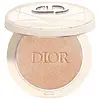Dior Mono Couleur Couture High-Color Eyeshadow Versus Dior Forever Couture Luminizer Highlighter Powder
What's inside
What's inside
 Key Ingredients
Key Ingredients

 Benefits
Benefits

 Concerns
Concerns

No concerns
 Ingredients Side-by-side
Ingredients Side-by-side

Calcium Sodium Borosilicate
Talc
AbrasiveIsononyl Isononanoate
EmollientEthylhexyl Isononanoate
EmollientPolybutene
Dimethicone
EmollientEthylene/Propylene/Styrene Copolymer
Caprylyl Glycol
EmollientTin Oxide
AbrasiveSodium Dehydroacetate
PreservativeEthylhexylglycerin
Skin ConditioningGlyceryl Caprylate
EmollientPinus Pentaphylla Seed Oil
EmollientCarthamus Tinctorius Seed Oil
MaskingButylene/Ethylene/Styrene Copolymer
Pentaerythrityl Tetra-Di-T-Butyl Hydroxyhydrocinnamate
AntioxidantAloe Barbadensis Leaf Juice
Skin ConditioningTocopherol
AntioxidantRosa Canina Fruit Oil
EmollientCI 19140
Cosmetic ColorantCI 42090
Cosmetic ColorantCI 77007
Cosmetic ColorantCI 77163
Cosmetic ColorantCI 77288
Cosmetic ColorantCI 77289
Cosmetic ColorantCI 77491
Cosmetic ColorantCI 77492
Cosmetic ColorantCI 77499
Cosmetic ColorantCI 77510
Cosmetic ColorantCI 77742
Cosmetic ColorantCI 77891
Cosmetic ColorantCalcium Sodium Borosilicate, Talc, Isononyl Isononanoate, Ethylhexyl Isononanoate, Polybutene, Dimethicone, Ethylene/Propylene/Styrene Copolymer, Caprylyl Glycol, Tin Oxide, Sodium Dehydroacetate, Ethylhexylglycerin, Glyceryl Caprylate, Pinus Pentaphylla Seed Oil, Carthamus Tinctorius Seed Oil, Butylene/Ethylene/Styrene Copolymer, Pentaerythrityl Tetra-Di-T-Butyl Hydroxyhydrocinnamate, Aloe Barbadensis Leaf Juice, Tocopherol, Rosa Canina Fruit Oil, CI 19140, CI 42090, CI 77007, CI 77163, CI 77288, CI 77289, CI 77491, CI 77492, CI 77499, CI 77510, CI 77742, CI 77891
Mica
Cosmetic ColorantCetearyl Ethylhexanoate
EmollientSilica
AbrasiveSqualane
EmollientOctyldodecyl Stearoyl Stearate
EmollientGlycerin
HumectantParfum
MaskingPolysorbate 80
Emulsifying1,2-Hexanediol
Skin ConditioningCaprylyl Glycol
EmollientPrunus Armeniaca Kernel Oil
MaskingEthylhexylglycerin
Skin ConditioningSynthetic Fluorphlogopite
Chondrus Crispus Extract
Skin ConditioningXanthan Gum
EmulsifyingPentaerythrityl Tetra-Di-T-Butyl Hydroxyhydrocinnamate
AntioxidantCetearyl Alcohol
EmollientDicalcium Phosphate
AbrasiveWater
Skin ConditioningTocopherol
AntioxidantButylene Glycol
HumectantHydrolyzed Viola Tricolor Extract
Skin ProtectingRosa Multiflora Fruit Extract
MaskingCI 77891
Cosmetic ColorantCI 77491
Cosmetic ColorantCI 77492
Cosmetic ColorantMica, Cetearyl Ethylhexanoate, Silica, Squalane, Octyldodecyl Stearoyl Stearate, Glycerin, Parfum, Polysorbate 80, 1,2-Hexanediol, Caprylyl Glycol, Prunus Armeniaca Kernel Oil, Ethylhexylglycerin, Synthetic Fluorphlogopite, Chondrus Crispus Extract, Xanthan Gum, Pentaerythrityl Tetra-Di-T-Butyl Hydroxyhydrocinnamate, Cetearyl Alcohol, Dicalcium Phosphate, Water, Tocopherol, Butylene Glycol, Hydrolyzed Viola Tricolor Extract, Rosa Multiflora Fruit Extract, CI 77891, CI 77491, CI 77492
Ingredients Explained
These ingredients are found in both products.
Ingredients higher up in an ingredient list are typically present in a larger amount.
Caprylyl Glycol is a humectant and emollient, meaning it attracts and preserves moisture.
It is a common ingredient in many products, especially those designed to hydrate skin. The primary benefits are retaining moisture, skin softening, and promoting a healthy skin barrier.
Though Caprylyl Glycol is an alcohol derived from fatty acids, it is not the kind that can dry out skin.
This ingredient is also used as a preservative to extend the life of products. It has slight antimicrobial properties.
Learn more about Caprylyl GlycolCi 77491 is also hydrated iron III oxide. It's sole purpose is to give a red/pink hue to products.
Iron III oxides are classified as inorganic chemicals for coloring.
Synthetically created Ci 77491 is considered safer than those naturally found. This is because the synthetically created version may contain less impurities. Iron oxides are generally non-toxic and non-allergenic.
Learn more about CI 77491Ci 77492 is also hydrated iron III oxide. It's sole purpose is to give a yellow hue to products.
Iron III oxides are classified as inorganic chemicals for coloring.
Synthetically created Ci 77492 is considered safer than those naturally found. This is because the synthetically created version may contain less impurities. Iron oxides are generally non-toxic and non-allergenic.
Learn more about CI 77492Ci 77891 is a white pigment from Titanium dioxide. It is naturally found in minerals such as rutile and ilmenite.
It's main function is to add a white color to cosmetics. It can also be mixed with other colors to create different shades.
Ci 77891 is commonly found in sunscreens due to its ability to block UV rays.
Learn more about CI 77891Ethylhexylglycerin (we can't pronounce this either) is commonly used as a preservative and skin softener. It is derived from glyceryl.
You might see Ethylhexylglycerin often paired with other preservatives such as phenoxyethanol. Ethylhexylglycerin has been found to increase the effectiveness of these other preservatives.
Pentaerythrityl Tetra-Di-T-Butyl Hydroxyhydrocinnamate (long name, huh?) is a synthetic antioxidant.
It is used to help stabilize other antioxidants or prevent the color from changing in a product.
As an antioxidant, it helps fight free-radical molecules. Free-radical molecules are capable of damaging our cells and other genetic material. Thus, antioxidants may reduce the signs of aging.
This ingredient is oil-soluble.
Learn more about Pentaerythrityl Tetra-Di-T-Butyl HydroxyhydrocinnamateTocopherol (also known as Vitamin E) is a common antioxidant used to help protect the skin from free-radicals and strengthen the skin barrier. It's also fat soluble - this means our skin is great at absorbing it.
Vitamin E also helps keep your natural skin lipids healthy. Your lipid skin barrier naturally consists of lipids, ceramides, and fatty acids. Vitamin E offers extra protection for your skin’s lipid barrier, keeping your skin healthy and nourished.
Another benefit is a bit of UV protection. Vitamin E helps reduce the damage caused by UVB rays. (It should not replace your sunscreen). Combining it with Vitamin C can decrease sunburned cells and hyperpigmentation after UV exposure.
You might have noticed Vitamin E + C often paired together. This is because it is great at stabilizing Vitamin C. Using the two together helps increase the effectiveness of both ingredients.
There are often claims that Vitamin E can reduce/prevent scarring, but these claims haven't been confirmed by scientific research.
Learn more about Tocopherol